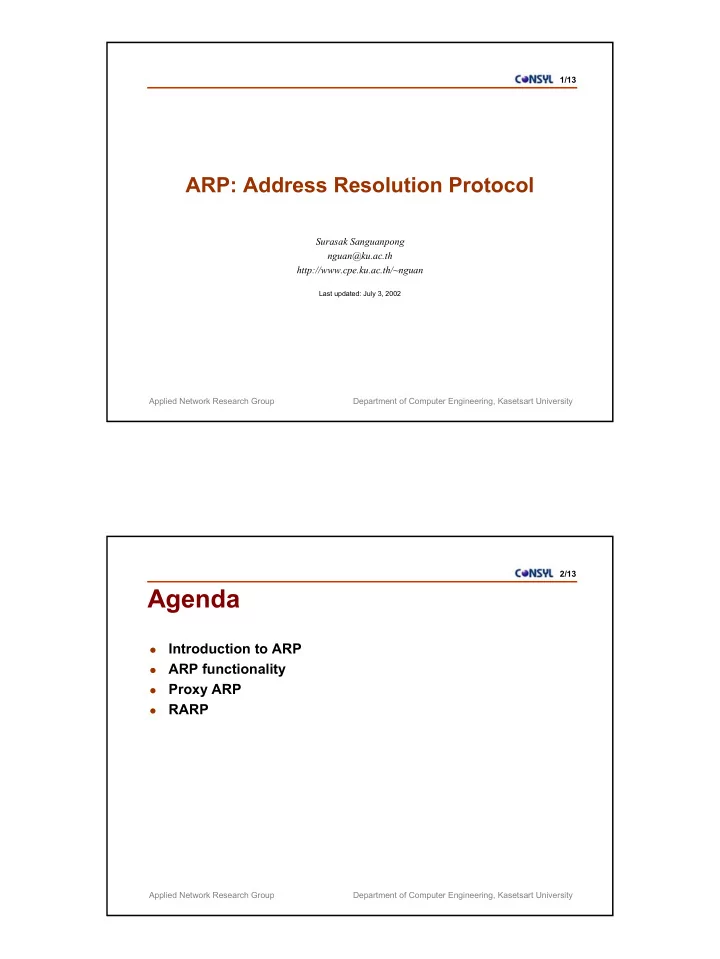

1/13 ARP: Address Resolution Protocol Surasak Sanguanpong nguan@ku.ac.th http://www.cpe.ku.ac.th/~nguan Last updated: July 3, 2002 Applied Network Research Group Department of Computer Engineering, Kasetsart University 2/13 Agenda Introduction to ARP � ARP functionality � Proxy ARP � RARP � Applied Network Research Group Department of Computer Engineering, Kasetsart University
3/13 ARP protocol ARP maps any � X-window TELNET BOOTP Others network level SMTP NNTP SNMP HTTP TFTP DNS NFS FTP address (such as IP address) to its corresponding data TCP UDP link address (such as Ethernet address) IP ICMP IGMP ARP RARP � RFC 826 - Ethernet Address Resolution Protocol (STD0037) � ARP is a supported protocol in the data link layers, not data link layer protocol Applied Network Research Group Department of Computer Engineering, Kasetsart University 4/13 ARP and RARP ARP and RARP perform dynamic mapping between Logical physical address address logical addresses and ARP physical addresses Address Resolution Protocol ARP maps a logical address to a � physical address i.e., IP address to Ethernet address � RARP maps a physical address to a physical Logical � logical address address address RARP i.e., Ethernet address to IP address � Reverse Address Resolution Protocol Applied Network Research Group Department of Computer Engineering, Kasetsart University
5/13 Ethernet frame 158.108.1.10 158.108.1.2 00:10:4B:13:0A:BC 8:0:20:7a:49:68 158.108.1.2 need to know the Ethernet address of 158.108.1.10 to create the complete Ethernet frame ?? 8:0:20:7a:49:68 ……… . 158.108.1.2 158.108.1.10 … . type Destination Source IP source IP destination Address Address address Address Ethernet Header IP Datagram Ethernet Frame Applied Network Research Group Department of Computer Engineering, Kasetsart University 6/13 ARP in operation 158.108.1.2 158.108.1.5 A want to resolve 8:0:20:7a:49:68 00:10:4B:13:0A:BC � MAC address of D A B C D A sends a broadcast � ARP request ARP request who has IP 158.108.1.5? 158.108.1.2 158.108.1.5 8:0:20:7a:49:68 00:10:4B:13:0A:BC D sends a unicast � A B C D ARP reply to A ARP reply me! with 00:10:4B:13:0A:BC Applied Network Research Group Department of Computer Engineering, Kasetsart University
7/13 ARP mechanisms Each node maintains the ARP cache � � it first looks in the cache to find entry first � if the entry is not used for a period (~15 minutes), it is deleted. Receive node can adds an MAC addr entry for source � station in its own cache. ARP traffic load � � hosts quickly add cache entries. � If all hosts on a subnet are booted at the same time? => flurry of ARP requests and reply. Applied Network Research Group Department of Computer Engineering, Kasetsart University 8/13 ARP as a command line entry in ARP table % arp -a www.cpe.ku.ac.th (158.108.33.5) at 0:0:e8:15:cc:c % telnet cc : more entries added % arp -a router.cpe.ku.ac.th (158.108.33.1) at 0:0:c:6:13:4a cc.cpe.ku.ac.th (158.108.33.2) at 2:60:8c:2e:b5:8b www.cpe.ku.ac.th (158.108.33.5) at 0:0:e8:15:cc:c Applied Network Research Group Department of Computer Engineering, Kasetsart University
9/13 ARP packet datalink frame frame hdr ARP/RARP message Hardware type:16 Protocol type:16 hlen:8 plen:8 ARP Operation:16 Sender MAC addr (bytes 0-3) sender MAC addr (bytes 4-5) sender IP addr (bytes 0-1) sender IP addr (bytes 2-3) dest MAC addr (bytes 0-1) dest MAC addr (bytes 2-5) dest IP addr (bytes 0-3) 0 15 16 31 Applied Network Research Group Department of Computer Engineering, Kasetsart University 10/13 Header details � hardware type : Ethernet=1 ARCNET=7, localtalk=11 � protocol type : IP=0x800 � hlen : length of hardware address, Ethernet=6 bytes � plen : length of protocol address, IP=4 bytes � ARP operation : ARP request = 1, ARP reply = 2 RARP request = 3, RARP reply = 4 Applied Network Research Group Department of Computer Engineering, Kasetsart University
11/13 ARP request packet 158.108.1.2 158.108.1.5 8:0:20:7a:49:68 00:10:4B:13:0A:BC ARP request Sample ARP request Ethernet packet FF:FF:FF:FF:FF:FF dest MAC (broadcast) 02:60:8c:2e:b5:8b source MAC 0x806 ARP frame type 0x001 0x800 Ethernet / IP 0x06 0x04 0x01 MAC=6/ IP=4 /request 8:0:20:7a:49:68 source MAC 158.108.1.2 source IP 0:0:0:0:0:0 dest MAC (unknown) 158.108.1.5 dest IP CRC Ethernet CRC Applied Network Research Group Department of Computer Engineering, Kasetsart University 12/13 ARP reply packet 158.108.1.2 158.108.1.5 8:0:20:7a:49:68 00:10:4B:13:0A:BC ARP reply Sample ARP reply Ethernet packet 8:0:20:7a:49:68 dest MAC (broadcast) 00:10:4B:13:0A:BC source MAC 0x806 ARP frame type 0x001 0x800 Ethernet / IP 0x06 0x04 0x02 MAC=6/ IP=4 /request 00:10:4B:13:0A:BC source MAC 158.108.1.5 source IP 8:0:20:7a:49:68 dest MAC (unknown) 158.108.1.2 dest IP CRC Ethernet CRC Applied Network Research Group Department of Computer Engineering, Kasetsart University
13/13 Proxy ARP One node answers ARP request for another: Router R � answers for Y IP:158.108.40.1 IP: 158.108.33.2 MAC: 00:00:e8:15:cb:0c IP:158.108.33.1 MAC: 02:60:8c:2e:b5:8b MAC: 00:00:0c:06:13:4a X Y X to Y request R R send 158.108.40.1 with 00:00:0c:06:13:4a � Useful when some nodes on a network cannot support subnet � X do not understand subnet, so it thinks that Y is on the same subnet � Router must be configured to be a proxy ARP Applied Network Research Group Department of Computer Engineering, Kasetsart University 14/13 RARP Reverse ARP : map MAC addr to IP addr � For device that can not store IP, usually diskless � workstations Need to setup server wit RARP table � Use the same frame format � � 0x0835 for Ethernet RARP request � operation 0x003 = RARP request 0x004 = RARP reply RARP can not operate across router, BOOTP is more � spread Applied Network Research Group Department of Computer Engineering, Kasetsart University
Recommend
More recommend